This guide focuses on the publication settings for Cdiscount, so it only explains how to fill in the sections available for this specific sales channel.
If you want guidance on all sections of the publication settings, including those not available Cdiscount, read the guide How to publish a catalogue.
N.B. Before you can publish on Cdiscount, you must configure the catalogue on SellRapido. If you have not configured it yet, click here to find out how.
Contents
Introduction
Publishing a catalogue on marketplaces or e-commerce sites involves two key steps:
1. Applying the publication settings
In this process, the key elements for the publication of products are defined: prices and mark-ups, shipping costs, payment methods and much more.
2. Applying the include and exclude filters
In this phase you must finalise the publication, by setting include and exclude filters in the Filters tab to establish which products to publish and which to exclude from publication
Below we see in detail how to apply the settings and how to finalise the publication of a catalogue on Cdiscount.
Publication settings
Defining publication settings is the first step towards publishing a catalogue.
To apply the publication settings, follow these steps:
1. Got to Pre-sales > Products, select the catalogue to be published, click on ![]() Settings and then on New.
Settings and then on New.
- Marketplace: Cdiscount
- Credential: the already configured credential appears. If you have configured more than one credential, choose the one you want to use
- Channel: France is the only country available on Cdiscount.
Click on OK.
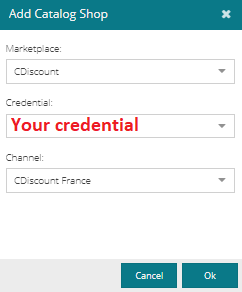 |
A row will be created with the sales channel attached. The status will initially be red; you need to apply the publication settings for it to turn green.
 |
2. Click on the dial ![]() . A window will open showing the settings to be applied in order to publish the products on Cdiscount.
. A window will open showing the settings to be applied in order to publish the products on Cdiscount. ![]()
Let us see in detail how the publication settings work.
General rules vs specific rules
Before defining the settings, it is essential to understand how the various tabs to be filled in are built, and, in particular, what the difference is between general and specific rules.
- General rules: these are set at the top of each tab. They are rules that apply to all products you publish on any given sales channel.
- Specific rules: these are set at the bottom of each tab. They are applied only to products that fall within the parameters you have specified.
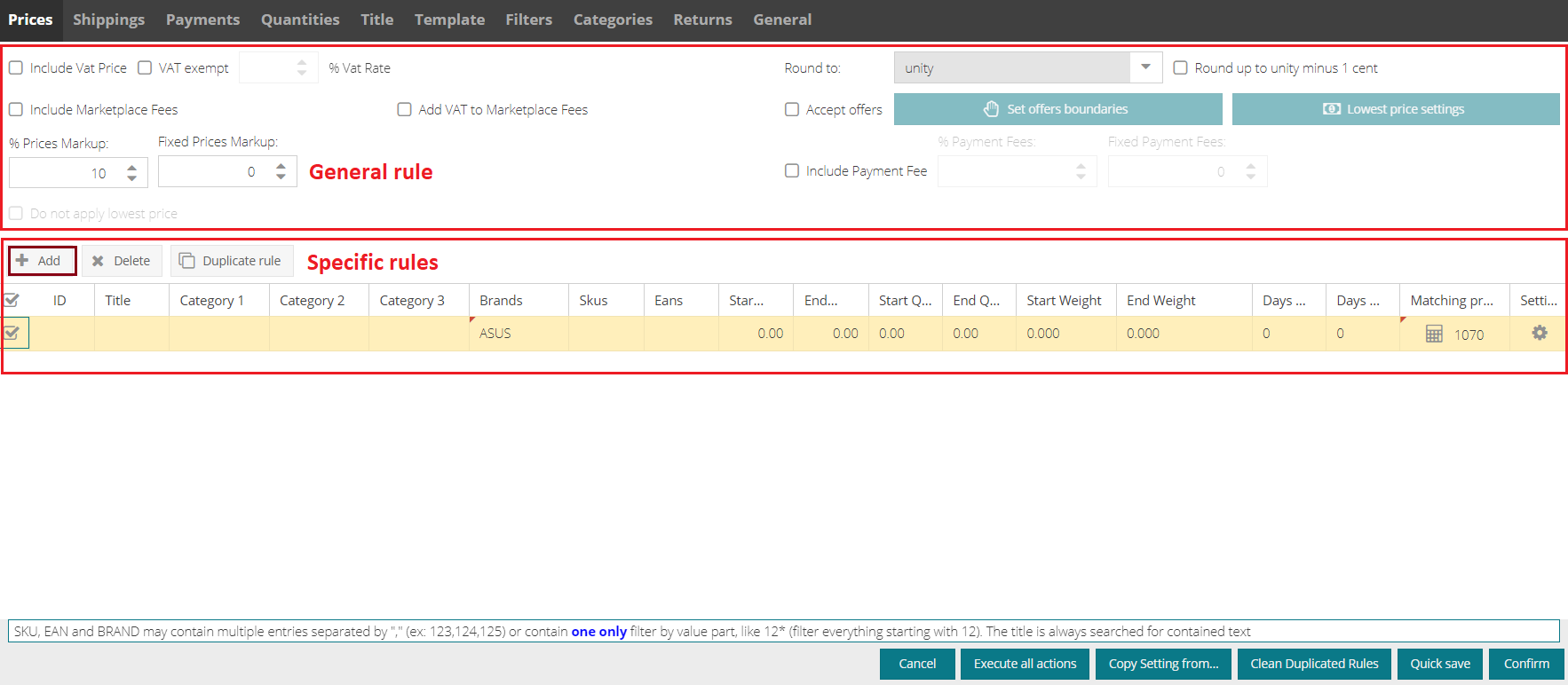 |
To set a specific rule:
1. Click on the New button. A row is created, indicating the products to which the rule will be applied.

The products to which the rule is to be applied can be filtered using the following parameters:
- Category 1 and/or 2 and/or 3
- Brand
- Individual or Groups of SKU
- Individual or Groups of EANS
- Price ranges
- Weight ranges
- Order preparation day ranges
2. When you have defined the parameters, click on ![]() Settings in the same row.
Settings in the same row.
This will open a window where you can set the rule that will be applied to products falling within the scope of the parameters of that row.
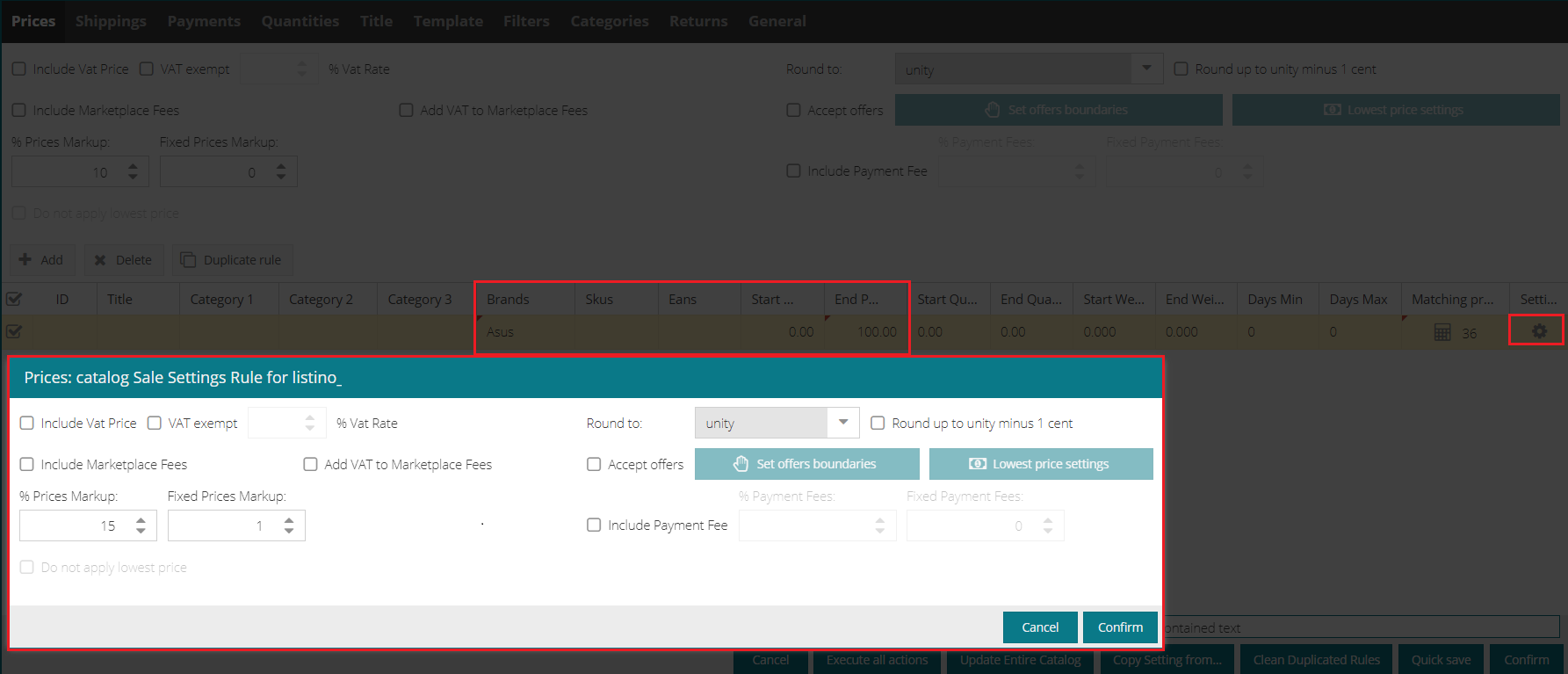 |
Example: a 15% mark-up and fixed mark-up of € 1 will be applied to all Asus brand products between € 0 and € 100.
How to fill in publication settings tabs
Once you understand how general rules and specific rules work, you can go on to define the settings.
Please bear in mind that the fields to be set may vary depending on the marketplace: when a section is not editable, it means that it cannot be managed for that specific marketplace (in this case Cdiscount).
Let us see in detail how to fill in each section:
Prices
In the Prices tab, you can manage various settings related to the price of the products to be published.
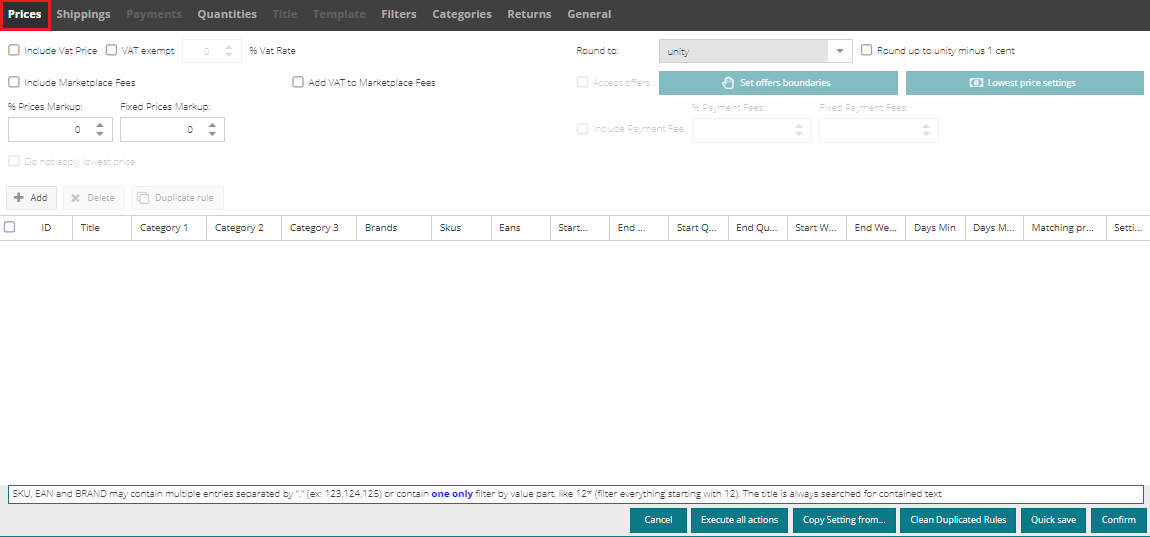 |
The fields to be filled in and the options that can be enabled in this tab are listed below:
1. Adding VAT to the priceTo add VAT to the price, flag this section and indicate the VAT percentage, if applicable.
Bear in mind that prices upstream of listings are generally exclusive of VAT.
But if, upstream in the catalogue, there is a column with a value stating the VAT percentage, do not flag this box: the system will add the VAT to the final price in the catalogue.
2. Adding Marketplace Commissions
This box allows the system to add the commission charged by the marketplace/e-commerce site to the final price based on the product category of each product.
3. Adding VAT to Marketplace commissions.
If this box is ticked, the system will add VAT to the commission charged by the marketplace.
N.B.: If you are registered in the VIES, do not flag this box.
4. Rounding off
You can choose to round the price to the decimal place (e.g. € 11.70) to the unit (e.g. € 12), or to the unit minus one cent (e.g. € 11.99).
5. Percentage price mark-up and fixed price mark-up
You can enter a percentage and or fixed mark-up to be added to the list price.
To apply a discount, enter a minus sign in front of the mark-up (e.g. “-5.00”).
All calculations are made using the catalogue currency.
At the time of submission, SellRapido converts the amounts to the currency of the target marketplace. For this reason, fixed mark-ups must always be in the currency of the listing.
6. Specific rules
As with any tab, at the bottom of the page you can set specific rules for groups of products that meet certain criteria (go back to the section general rules vs specific rules to recall in detail how to do this).
Shipping
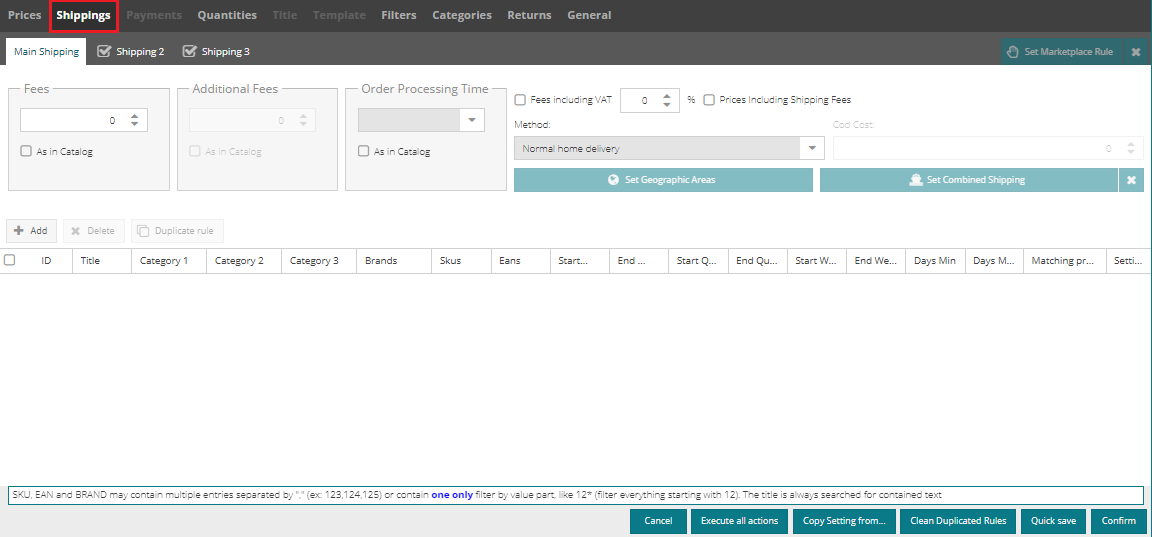 |
In this tab you can fill in the following fields:
1. Fees
Enter Taken from listing if this information is present upstream in the catalogue. If it is not, fill the field with the shipping cost (the cost will always be shifted onto the price).
2. Order preparation times
Enter Taken from listing if this information is present upstream in the catalogue, otherwise it indicates the number of days it takes to prepare the order.
The value must be greater than or equal to 1 day.
N.B.: you cannot set more than 10 preparation days.
3. VAT inclusive fee
If the shipping cost entered in the Fees field is exclusive of VAT, flag the Vat inclusive fee option and enter the percentage of VAT to be applied.
4. Method
For Cdiscount it is mandatory to set all three shipping methods. If they are not selected, the system will generate an error.
Quantities
On this tab you can set the quantity of products that will appear in the ad.
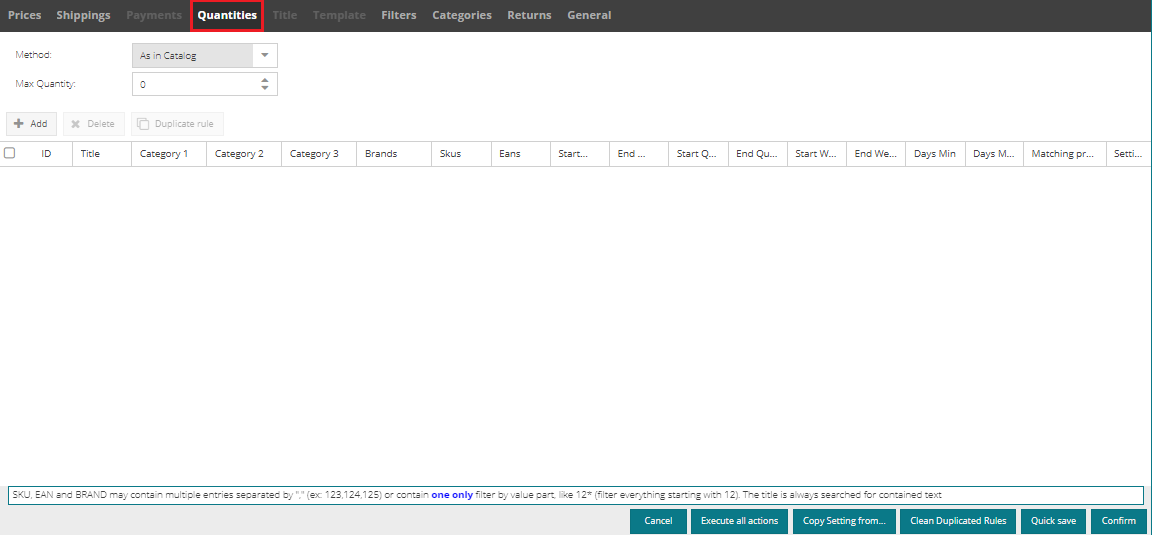 |
There are 3 ways to manage this data (selectable from the Method drop-down list ):
- import the quantities from the listing
- set a fixed quantity by entering the number of pieces to be displayed in the field.
- set a random quantity to publish a random quantity within the range of the two numbers entered in the two boxes.
You also have the option to set a maximum quantity of pieces to be displayed in the ad.
Filters
In this tab you can finalise publication on the sales channel by setting filters to include or exclude certain products from publication.
To see in detail how to do this, go to the section Publishing the catalogue.
For Cdiscount, we recommend a minimum of 30 pieces for each include filter.
Categories
In this tab you must associate Categories 1/2/3 (i.e. those in the upstream list) with the Channel Category (i.e. the category in use for the sales channel you are publishing on). The latter allows SellRapido to calculate the commission provided by the marketplace / e-commerce for a given product category.
N.B.: the marketplace commission calculated via the channel category is the one that will be applied when calculating product prices via the Add Marketplace Commission button (see step 2 of the Prices section).
Therefore, care must be taken during this step to set the channel categories correctly to avoid setting the wrong commission.
Below we see in detail how to associate upstream listing categories with the channel category.
Associate channel categories
1. select one or more rows of categories by flagging the relevant box
2. click on the button ![]() on one of the selected rows
on one of the selected rows
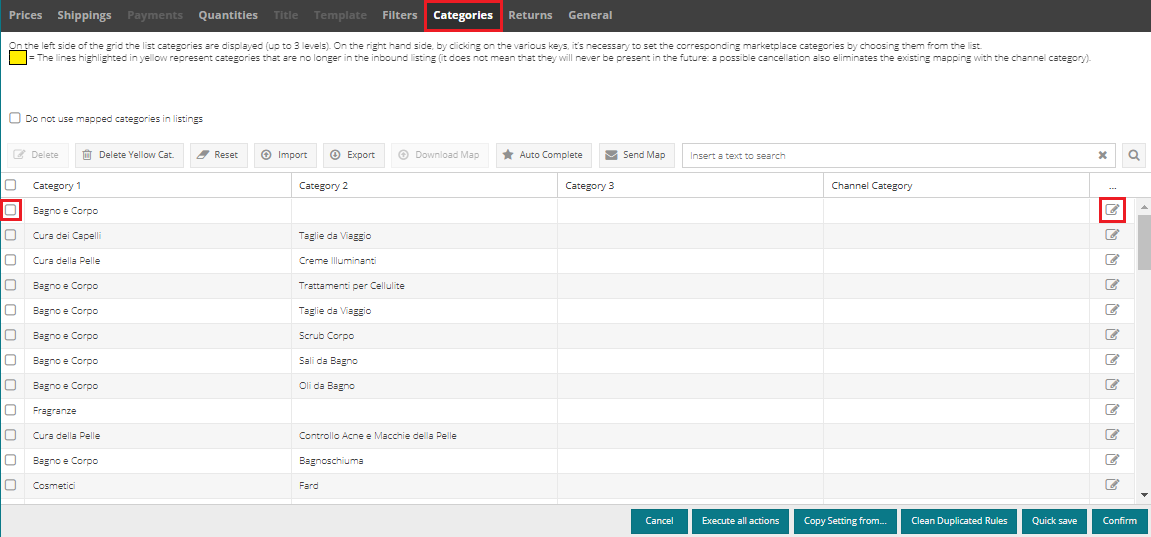 |
3. choose the channel category that best fits categories 1/2/3 and click on the arrow ![]() to set it.
to set it.
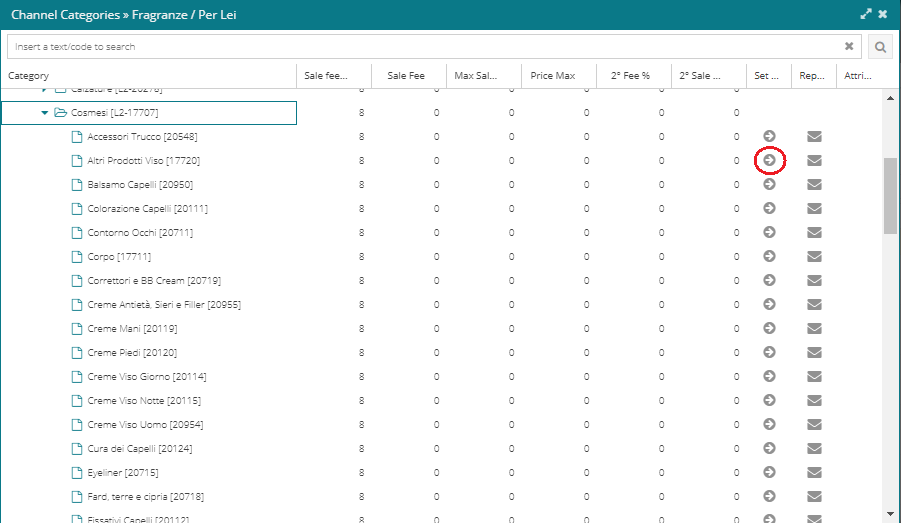 |
If you selected several rows in the previous step, the same channel category will be set for all the rows selected.
4. when set, click on Confirm at the bottom right corner to save.
Returns
In this tab you must enter the postcode of the address where the products are shipped from.
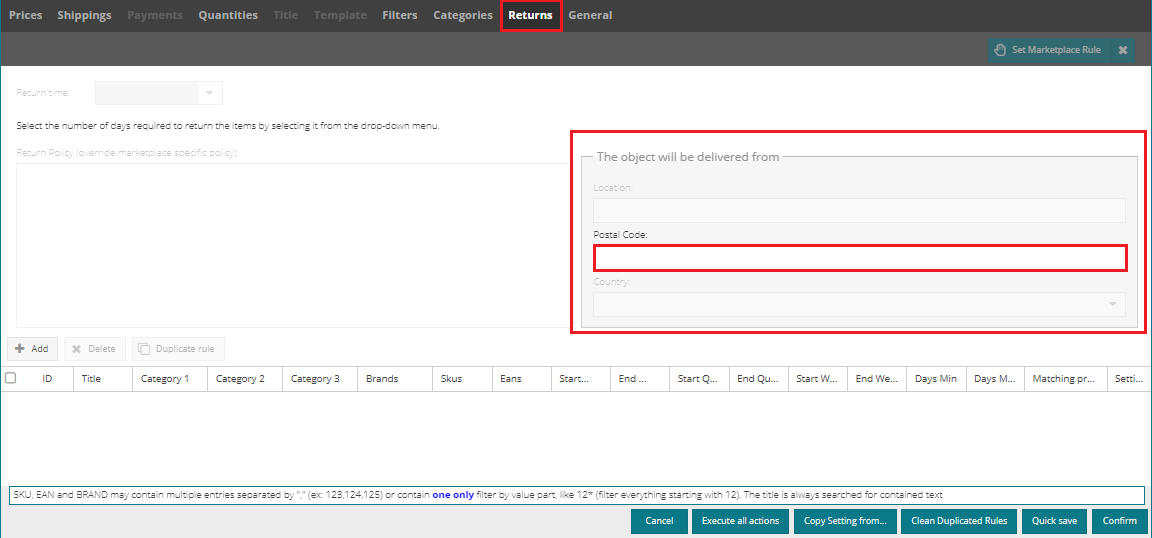 |
Publishing the catalogue on a sales channel
As explained in previous sections, a catalogue is published by inserting an include filter.
In the Filters tab, Include or Exclude filters must be set to identify which products to publish and which to exclude from publication.
 |
Products can be filtered under the following parameters:
- Category 1 / 2 / 3
- Brand
- SKU
- EAN
- Price range
- Min./max. quantity
- Weight range
- Order preparation day ranges
To create a new rule, click on New and set the parameters to filter the products.
N.B.:
The insertion of a total inclusion filter is strongly discouraged.
We advise you to publish products at a gradual pace, especially if the marketplace account you are using has just been opened.
To create a new rule, click on New and set the parameters to filter the products.
Example:
In the example image, all products that meet the following parameters will be published:
- Category 1: Cosmetici
- End Price: 100
- Start Quantity: 20
- Matching products: 905
Under this rule, the system will then publish all products between € 0 and € 100, belonging to the Cosmetici Category 1, and a Start Quantity 20.
Include/exclude by brand
To include or exclude products of different brands, enter their names (including any spaces, e.g. Infinity Light) in the Brands field, separating them with a comma.
N.B.: there should be no spaces before and after a comma.
Example: canon,infinity light,zyxel
Checking the ad reports
After publishing a catalogue, it is essential to monitor the Ad Reports to check the status of publications.
This is a very important step, as it will allow you to detect any errors and make the necessary changes for successful publication of products.
Click here to read the guide on checking your Ad Reports.
-1.png?height=120&name=logo_sellrapido_ottanio%20(1)-1.png)